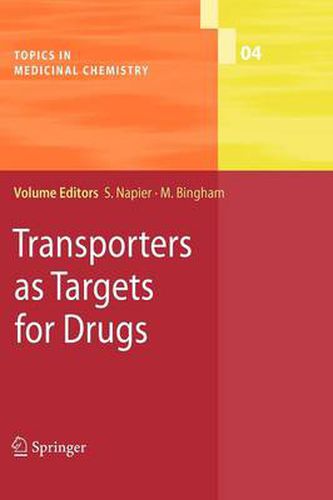Readings Newsletter
Become a Readings Member to make your shopping experience even easier.
Sign in or sign up for free!
You’re not far away from qualifying for FREE standard shipping within Australia
You’ve qualified for FREE standard shipping within Australia
The cart is loading…






This title is printed to order. This book may have been self-published. If so, we cannot guarantee the quality of the content. In the main most books will have gone through the editing process however some may not. We therefore suggest that you be aware of this before ordering this book. If in doubt check either the author or publisher’s details as we are unable to accept any returns unless they are faulty. Please contact us if you have any questions.
Transporters are proteins that span the plasma membrane and regulate the traf?c of small molecules in and out of the cell. They play a particularly important role in chemical signalling between neurons in the CNS, where they act to control the concentration of neurotransmitters in the synapse. In most systems the termination of chemical transmission is achieved by rapid uptake of the transmitter molecule from the synapse by transporters located on the synaptic terminal or surrounding glial cells. Another key role for transporters is in excluding undesirable xenobiotics from the cell, whilst allowing key molecules required for the cell life cycle to enter. It is incre- ingly recognised that these ef?ux or uptake transporters respectively, play an important role in the disposition of many marketed drugs, and whilst the ?eld of drug transport is yet to attain the level of maturity of drug metabolism,itiscertaintobeofincreasingimportance infuturedrugdisc- ery programmes. 2 Transporter Classification Transporters can be classed into two main families; the ATP binding c- sette (ABC) family, and the solute carrier (SLC) family. The SLC family is a very broad categorisation which encompasses, amongst others, three - portant families of transporters for organic molecules; the major facilitator superfamily (MFS) and two neurotransmitter transporter families, the neu- transmitter; sodium symporter (NSS, or SLC6) and the dicarboxylate/amino + + acid:cation (Na or H ) symporter (DAACS, or SLC1) family.
$9.00 standard shipping within Australia
FREE standard shipping within Australia for orders over $100.00
Express & International shipping calculated at checkout
This title is printed to order. This book may have been self-published. If so, we cannot guarantee the quality of the content. In the main most books will have gone through the editing process however some may not. We therefore suggest that you be aware of this before ordering this book. If in doubt check either the author or publisher’s details as we are unable to accept any returns unless they are faulty. Please contact us if you have any questions.
Transporters are proteins that span the plasma membrane and regulate the traf?c of small molecules in and out of the cell. They play a particularly important role in chemical signalling between neurons in the CNS, where they act to control the concentration of neurotransmitters in the synapse. In most systems the termination of chemical transmission is achieved by rapid uptake of the transmitter molecule from the synapse by transporters located on the synaptic terminal or surrounding glial cells. Another key role for transporters is in excluding undesirable xenobiotics from the cell, whilst allowing key molecules required for the cell life cycle to enter. It is incre- ingly recognised that these ef?ux or uptake transporters respectively, play an important role in the disposition of many marketed drugs, and whilst the ?eld of drug transport is yet to attain the level of maturity of drug metabolism,itiscertaintobeofincreasingimportance infuturedrugdisc- ery programmes. 2 Transporter Classification Transporters can be classed into two main families; the ATP binding c- sette (ABC) family, and the solute carrier (SLC) family. The SLC family is a very broad categorisation which encompasses, amongst others, three - portant families of transporters for organic molecules; the major facilitator superfamily (MFS) and two neurotransmitter transporter families, the neu- transmitter; sodium symporter (NSS, or SLC6) and the dicarboxylate/amino + + acid:cation (Na or H ) symporter (DAACS, or SLC1) family.